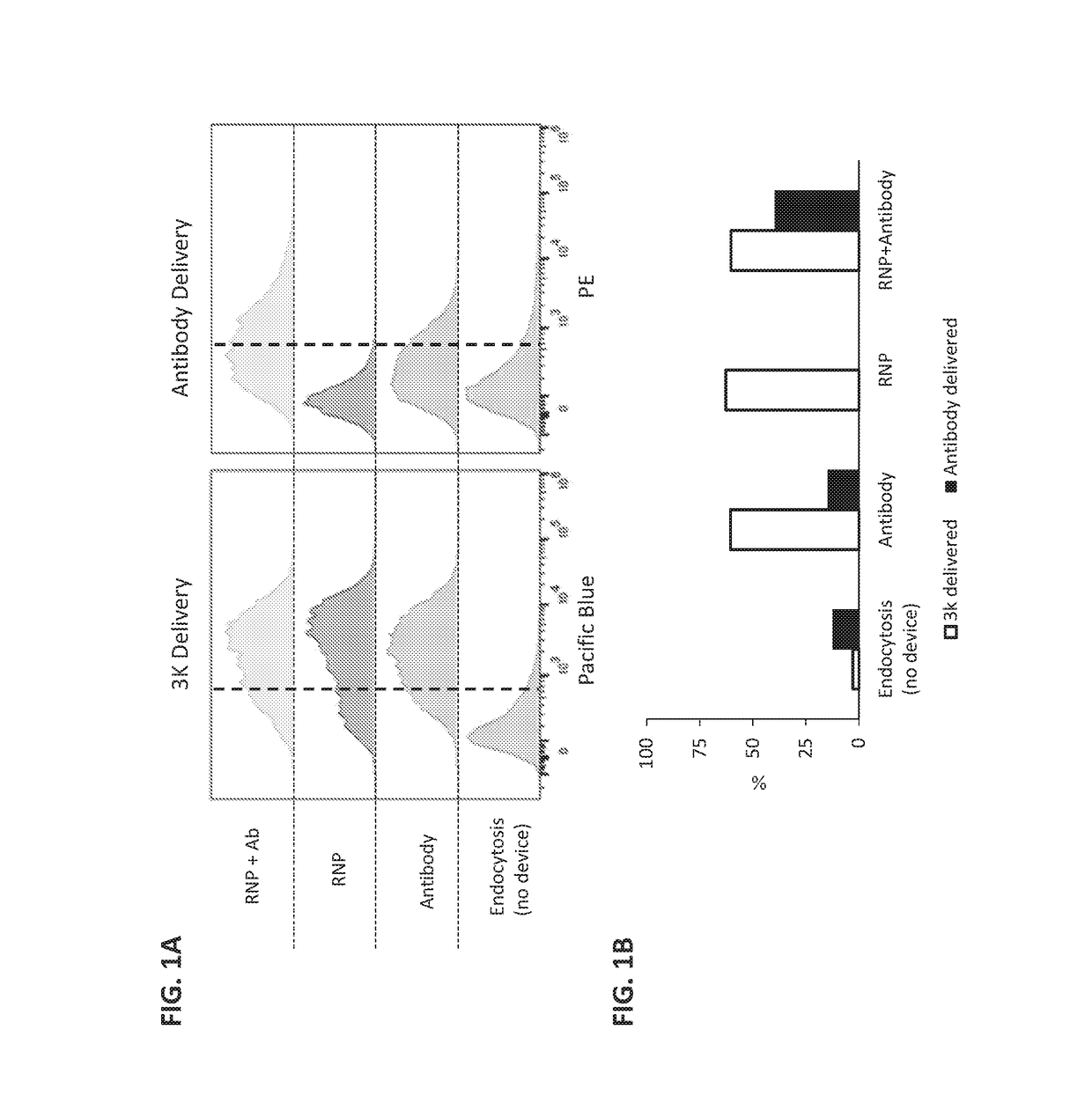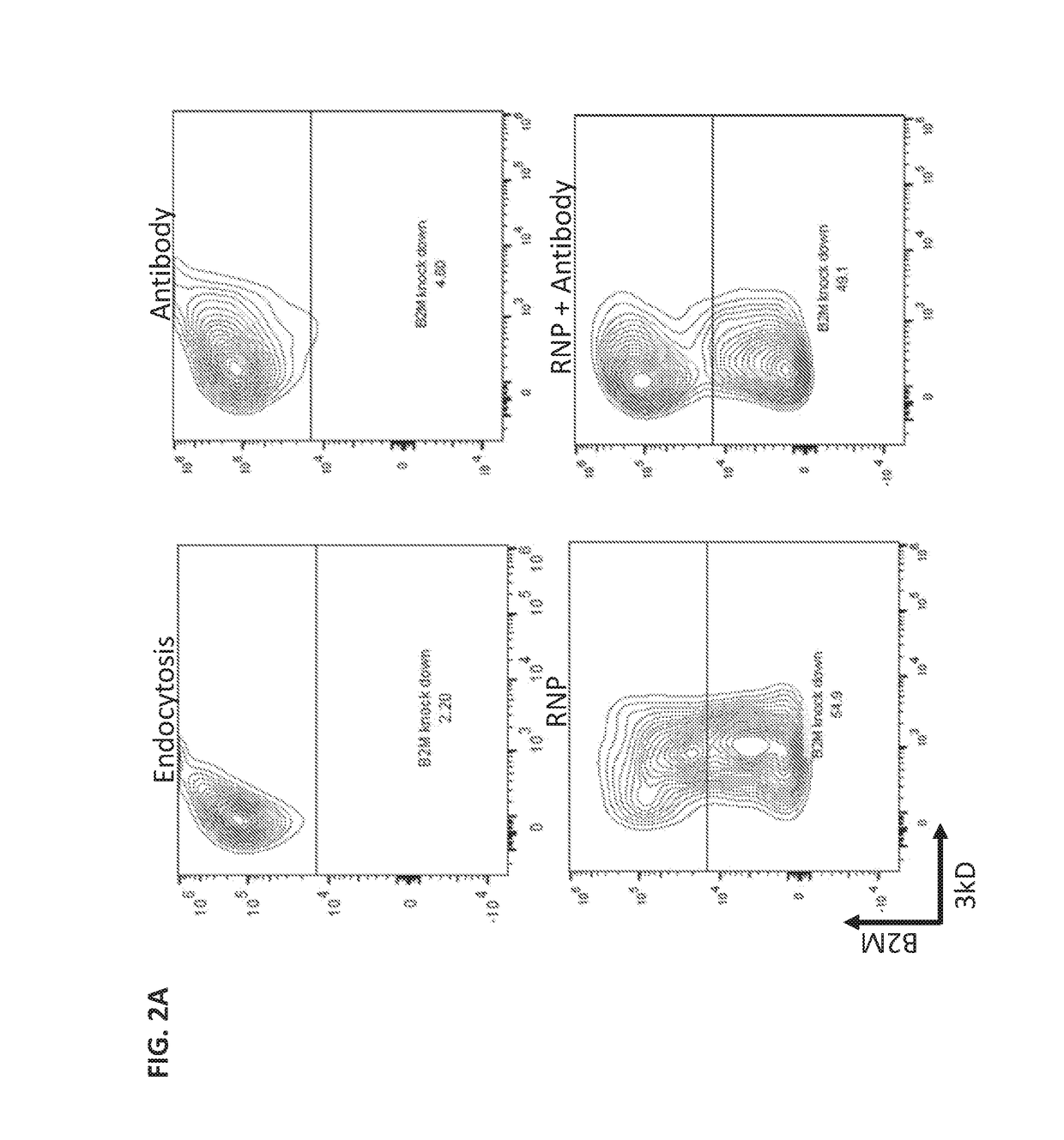Intracellular delivery of complexes
a complex and intracellular technology, applied in the direction of cell culture active agents, biochemistry apparatus and processes, genetically modified cells, etc., can solve the problems of non-specific molecule delivery, high cell death, modification or damage of payload molecules
- Summary
- Abstract
- Description
- Claims
- Application Information
AI Technical Summary
Benefits of technology
Problems solved by technology
Method used
Image
Examples
example 1
ion-mediated delivery of complexes
[0202]A series of experiments are undertaken in cells to demonstrate constriction-mediated delivery of complexes.
[0203]Cultured cells are harvested, counted, washed and resuspended at 10-20×106 cells / mL in cell culture media for delivery. Polypeptide-nucleic acid complexes are assembled in vitro prior to contact with cells. Complexing conditions, including complex concentration, solution osmolarity, salt concentration, temperature, pH, serum and surfactant content, and viscosity are optimized to ensure that the formed complexes remain in a stable, intact form until post-delivery to the cells. Cell suspensions are passed through two different microfluidic chips, 10-6 or 10-7 chip at pressures of 60 and 90 psi. The chips have constrictions of the same width (4 microns) but have two different constriction lengths (30 vs. 10 microns). After passing through the constriction, the cells are incubated with the pre-assembled complexes to allow for delivery o...
example 2
ion-mediated delivery of complexes to T cells
[0205]A series of experiments are undertaken in unstimulated human T cells to demonstrate constriction-mediated delivery of complexes.
[0206]Fresh PBMCs are isolated from human blood using a standard Ficoll gradient. Next, T cells are negatively selected (Human T cell enrichment kit (StemCell Technologies)) counted, washed and resuspended at 10-20 ×106 cells / mL in OptiMEM for delivery. Polypeptide-nucleic acid complexes are assembled in vitro prior to cell constriction. Complexing conditions, including complex concentration, solution osmolarity, salt concentration, temperature, pH, serum and surfactant content, and viscosity are optimized to ensure that the formed complexes remain in a stable, intact form until post-delivery to the T cells. T cell suspensions are passed through two different microfluidic chips, 10-4 and 30-4, at pressures of 60 and 90 psi. The chips have constrictions of the same width (4 microns) but have two different co...
example 3
ion-mediated delivery of protein / protein / nucleic acid complexes to HEK293 cells
[0208]In this study, constriction-mediated delivery of a protein / protein / nucleic acid complex was evaluated. The complex contained a ribonucleoprotein (RNP) complex containing CAS9 protein and guide RNA (gRNA) designed to knockdown the B2M locus complexed in vitro with fluorescently labeled anti-CAS9 IgG antibody.
[0209]First, the RNP complex was formed by combining 10 μg of recombinant CAS9 protein (PNA Bio) with a 2.5 molar excess of unmodified gRNA (PNA Bio) designed to specifically target the B2M locus, followed by incubation on ice for 20 minutes. Next, anti-CAS9 IgG antibody (Cell Signaling Technology) was complexed at room temperature with the RNP complex at a 1:11 molar ratio of antibody:RNP. HEK293 cells were counted, washed, and resuspended at 10-20×106 cells / mL in OptiMEM containing the antibody / CAS9 / gRNA complex. The antibody / CAS9 / gRNA complex was delivered to the cells by passing the cell susp...
PUM
| Property | Measurement | Unit |
|---|---|---|
| Temperature | aaaaa | aaaaa |
| Temperature | aaaaa | aaaaa |
| Temperature | aaaaa | aaaaa |
Abstract
Description
Claims
Application Information
 Login to View More
Login to View More - R&D
- Intellectual Property
- Life Sciences
- Materials
- Tech Scout
- Unparalleled Data Quality
- Higher Quality Content
- 60% Fewer Hallucinations
Browse by: Latest US Patents, China's latest patents, Technical Efficacy Thesaurus, Application Domain, Technology Topic, Popular Technical Reports.
© 2025 PatSnap. All rights reserved.Legal|Privacy policy|Modern Slavery Act Transparency Statement|Sitemap|About US| Contact US: help@patsnap.com



